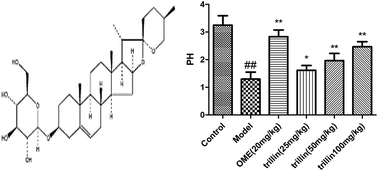Protective effect of trillin against ethanol-induced acute gastric lesions in an animal model
Abstract
The purpose of the present study was to evaluate gastroprotective effect of trillin on mucosal lesions induced by ethanol. Mice were orally administered with trillin (25 mg kg−1, 50 mg kg−1, 100 mg kg−1) or OME (20 mg kg−1). 1 hour later, the mice were intragastrically given ethanol (0.2 ml kg−1) and were sacrificed at 4 h after ethanol administration. Compared with the ethanol group, trillin treatment significantly showed increased levels of superoxide dismutase (SOD) in serum, decreased malonaldehyde (MDA) content in serum and decreased activity of myeloperoxidase (MPO) in stomach tissues, which suggested that trillin could prevent oxidative damage. Meanwhile, the serum levels of interleukin-6 (IL-6), interleukin-1β (IL-1β) and tumor necrosis factor-α (TNF-α) declined after pretreatment with trillin. In HE staining sections, ameliorative pathological changes of gastric lesions were markedly observed in the trillin group compared with those in the ethanol group. In the mechanistic study, the data showed that pretreatment with the trillin also effectively down-regulated protein expressions of p-NF-κBp65, p-IκBα and COX-2 in stomachs compared with those in the model group. Taken together, it could be concluded that trillin represented a potential therapeutic option to reduce the risk of gastric ulceration.


 Please wait while we load your content...
Please wait while we load your content...